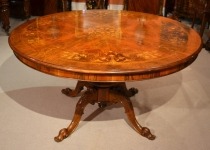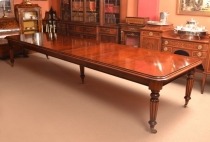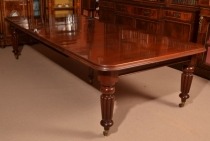Victorian dining tables – a very popular choice for the collector and investor.
 Solid furniture makes a solid investment – a buyer’s guide to Victorian dining tables
Solid furniture makes a solid investment – a buyer’s guide to Victorian dining tables
The Victorian era – culture and context
Queen Victoria reigned from 1837 to 1901 and this was a prolonged period of relative peace and prosperity corresponding with the pinnacle of the power and influence of the British Empire. This was a time of refined sensibilities, and great national self-confidence for the British.
A period of huge advances in science, technology, commerce and manufacturing – the dawn of the railways, electricity, photography, the telephone and mass production. It was also an era in many ways dominated by the burgeoning middle classes and saw the development of the middle class home.
Bourgeois life was centred on interior space, on privacy, morality and conservative respectability. All of these historical, cultural, and economic trends had a strong influence on the furniture produced at the time including the Victorian dining table.
The Victorian dining table – styles and materials
 Much Victorian furniture is characterised by exaggerated curves, heavy proportions, ornate decoration and dark wood. Despite the advancements towards modern times furniture makers looked to the past and the reassurance of history with strong Gothic and Louis XV influences which can for example be seen in the elaborate carving of dining table legs.
Much Victorian furniture is characterised by exaggerated curves, heavy proportions, ornate decoration and dark wood. Despite the advancements towards modern times furniture makers looked to the past and the reassurance of history with strong Gothic and Louis XV influences which can for example be seen in the elaborate carving of dining table legs.
Victorian dining tables because of their robust, dark and solid feel, often have a strong sense of presence which can be enhanced by research in to their provenance – some of the most collectable pieces are associated with famous people or have interesting stories behind them.
There are three main characteristics of Victorian dining tables –
1. Dark woods – Most Victorian tables are made from dark woods particularly mahogany, rosewood, and walnut. Reproductions on the other hand are usually made from other woods, such as oak, which may have been stained with dark, deep browns.
2. Heavy proportions – Victorian tables generally feel very substantial and robust featuring large surfaces and bulky pedestals.
3. Curves and carvings – The legs of Victorian tables are meticulously carved by hand or machine and generally curve at the bottom.
Many of the finest examples of Victorian dining table on the market today are made from beautiful, hand crafted flame mahogany and maybe eight or ten feet long and often feature patented special winding mechanism for extending the leaves.
Popular Victorian Table Makers and Designers
Some of the most collectable designers of Victorian dining tables were also architects and many were widely associated with the Arts and Crafts movement of the later Victorian era which stood for traditional craftsmanship, simpler forms and medieval, romantic or folk styles of decoration. Famous British designers to look out for include – Edward William Godwin, Augustus Welby Northmore Pugin, George Washington Jack, George Edmund Street, Philip Webb and Arthur Heygote Mackmurdo.
 At Regent Antiques we source some of the most beautiful and substantial pieces of antique Victorian furniture including some very impressive dining tables which can be both a sound investment and a fabulous centrepiece to your dining room. Please see our current inventory for further details or email or call for specialist advice.
At Regent Antiques we source some of the most beautiful and substantial pieces of antique Victorian furniture including some very impressive dining tables which can be both a sound investment and a fabulous centrepiece to your dining room. Please see our current inventory for further details or email or call for specialist advice.

